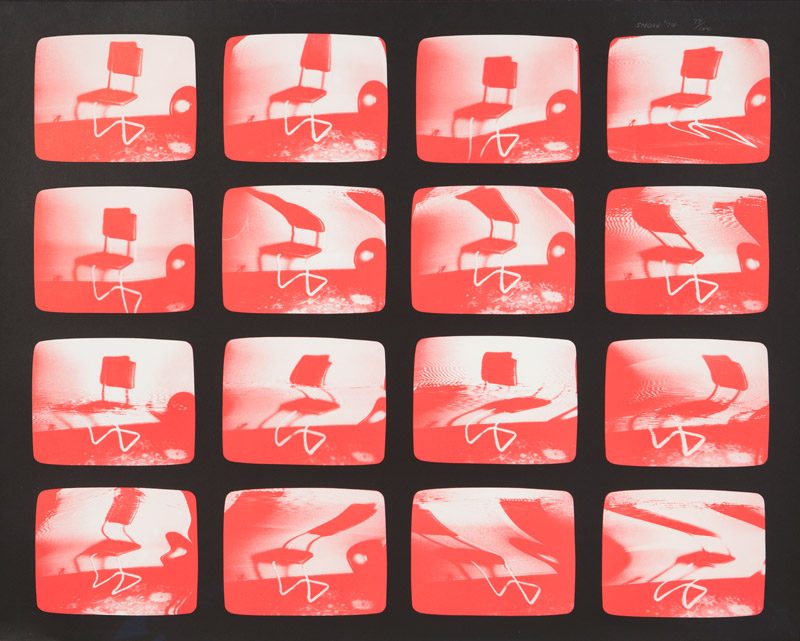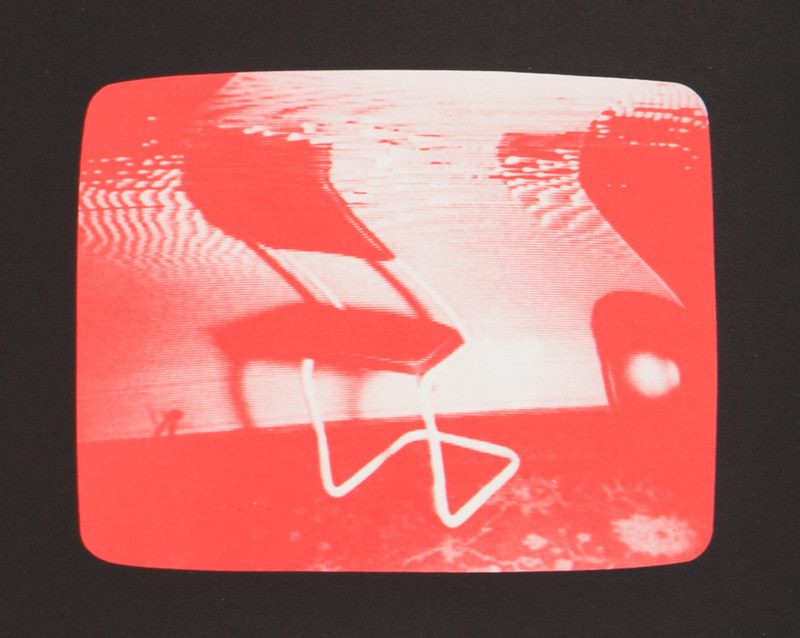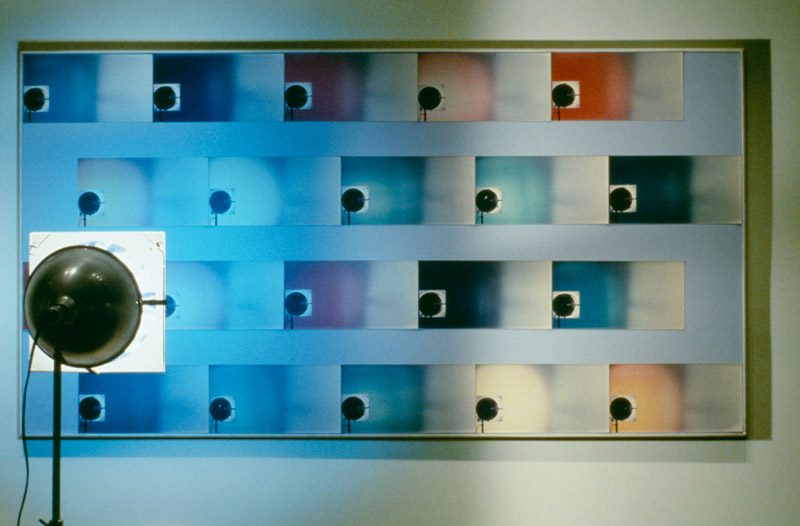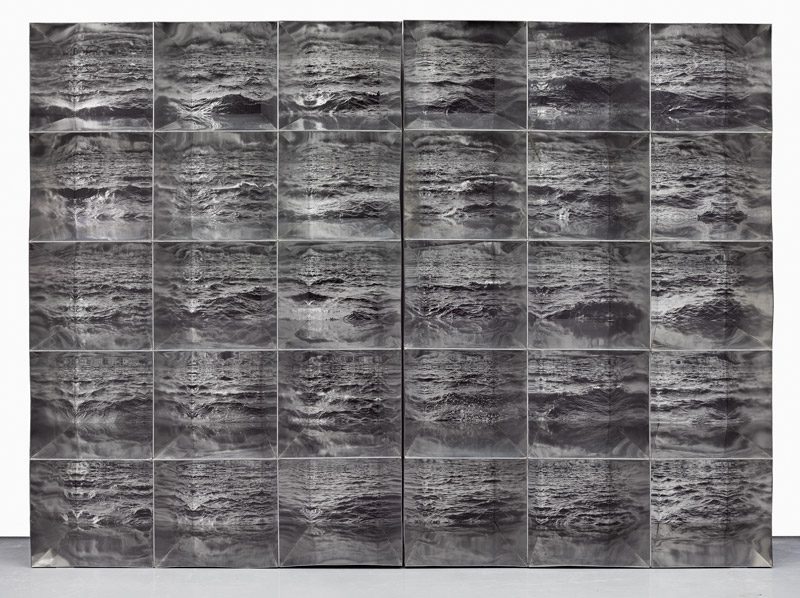By Robert Fones
As a child, I learned from a book on cartooning that my mother bought me that a cartoon character’s body could be distorted or exaggerated to express astonishment or alarm. I vividly recall an illustration in the book of a character with eyes popped out, jaw dropped to the navel, and the whole body stretched vertically. I also saw this physical distortion in the cartoons I watched on television after school. When Wile E. Coyote tries to drop a boulder on Roadrunner, his own feet are accidentally tied to the boulder. The boulder and his feet plunge to the bottom of the canyon while his head remains near the precipice, still registering the shock and dismay of his mistake. Perhaps this is why, when I first saw Michael Snow’s print 1956, A Videoprint (1974), I saw it in terms of a cartoon sequence.
The structure of 1956, four images across, four images down, arranged in a grid, suggests a sequence that can be read from left to right, top to bottom, following the conventions of reading text and comic-book panels. Each panel – to use the comic-book term for a single frame – of 1956 is in the shape of a 1950s-style rounded rectangular television screen and depicts the image of a modernist bent-metal tubing chair sitting on a Persian carpet. Something is plugged into a wall outlet, probably the flood lamp that illuminates the chair and casts a shadow of it onto the wall behind. But each image is different.
The image in the first panel on the upper left is normal, but all subsequent images are distorted to varying degrees. In the second panel, the chair appears to react to something in front of it; its back stretches up to the top of the screen. Then, in panel three, it dips its right foot toward the bottom; it pulls both feet back in panel four; in panel five, it dips its left foot down. The sequence continues, getting a bit crazier, with the last two panels on the bottom right the most wildly distorted.
Snow achieved this effect, he revealed to me when I went to buy the print from him, by holding a magnet up to a video monitor on which there was an image of the chair. The magnet pulled the electron gun in the video monitor out of alignment, causing the image to be distorted. That sounds simple enough, but, as with much of Snow’s work, there is more here than meets the eye. By distorting the image, he directs our attention to behind-the-scenes processes and unseen apparatuses. As if to signal this manipulation, his sixteen-panel sequence is printed in red on a black background, distancing the image from its original black-and-white video source. It’s obvious that the printed image is derived from a 1970s video monitor because of the horizontal scan lines visible in each television-shaped panel. These scan lines are indicative of cathode ray tube technology, the common form of black-and-white video image generation four decades ago.
Before the image of the chair and its environment could get to the video monitor, it had to be shot by a video camera. The video camera and monitor probably formed a closed loop, meaning that the image that appeared on the screen was live. Then, Snow or an assistant distorted the image by holding a magnet up to the monitor. Somehow, the distorted image had to be frozen or captured in order to get the sixteen images used in the print. Most likely, Snow used a film camera or a Polaroid camera (which Snow also owned and used at this time) to capture at least sixteen shots of variously distorted images. The images that appear in the print are, consequently, multiple generations of reproductions of images that were transferred from video camera to monitor, to negative film or Polaroid prints, to photographic prints, to stripped-up negatives, to printing plate on an offset press, to paper.
When we reconstruct the process of the work’s creation, some inconclusive details emerge. Why is the hand holding the magnet not visible in the print? Was it to the side of the monitor when the photographs were taken, or was some other method used to freeze and capture the distorted images? Is the video camera aimed at a real set-up of chair, rug, and flood lamp, or is it aimed at a black-and-white photograph of the scene? Both would result in the same kind of image on the monitor. Although 1956 reveals many things about the process of its own creation, these are details that can’t be easily resolved, and such uncertainties are part of what makes this work so intriguing.
Snow used grids or sequences of photographs in other works that preceded 1956 and in pieces produced around the same time. 1956 is similar in structure to the photo-sculpture Atlantic (1967). In this work, thirty photographs of the Atlantic Ocean are arranged in a grid six across and five down within a stainless steel structure. Like 1956, each image in Atlantic is different, so one assumes that they are different moments in time. Since the basic appearance of all of the images in both works does not vary significantly, it is safe to assume that the camera was fixed, the lighting didn’t change, and the photographs were taken one after another within a relatively limited period of time. Also in both works, Snow displays the photos in a grid, giving viewers the opportunity to see them as either discrete or sequential moments in time. There is no guarantee that they are arranged chronologically from top left to bottom right. The similarity of all the photographs in Atlantic suggests that there is no particular order. In 1956, however, the fact that there is an undistorted image in the upper left suggests a sequential reading starting from this image and proceeding in the normal direction of reading, from left to right, top to bottom. Another significant difference between Atlantic and 1956 is that in Atlantic the ocean is changing and hence each image is unique. In 1956, each image is visually different but the set-up of chair, carpet, and flood lamp is static.
In the seven years between Atlantic and 1956, Snow’s interest clearly shifted. The more recent work, 1956, is a mediated image, with extensive technological processing between the original set-up and the final image and evidence of the process of the work’s creation. Other works from the same year as 1956 share these characteristics.
Red 5 (1974) is a photographic document of its own creation. It begins with a large photograph of a red surface with glare along the upper edge. As each subsequent photograph is taken, it is placed on top of the original large photograph. The first photograph, presumably a Polaroid, captures only the red surface and glare. Each subsequent photograph includes smaller images of the previous photographs. Scale is the tell-tale indicator of the step-by-step process. Scale is something we don’t normally think about when we look at photographs, but here Snow makes it obvious that photographs change the scale of reality. The photographs have been moved after each photograph is taken, so what appears initially as a document of accumulation is instead a record of intervention.
Snow’s intervention in the position of the photographs is also recorded in each subsequent Polaroid. By comparing later photographs to earlier ones, we can detect the change in position. The four slightly curled Polaroids that appear in the final photograph cast shadows that are consistent with a single light source, suggesting that the glare in the original photograph was created with a real light source. In 1956, instead of manipulating physical Polaroid prints, Snow has manipulated the image itself during its transmission within video technology. The process of creation is implied rather than explicit, as it is in Red 5.
In Light Blues (also made in 1974), Snow documents the process of the work’s creation and re-creates the set-up in which it was created. Light Blues consists of twenty photographs of light projected through colour gels onto a blue panel. Snow then placed each of the twenty photographs, taken with ten different-coloured gels, on the blue panel in four rows, staggered like bricks. The set-up of lamp and subject matter is similar to 1956, except that in the latter work Snow photographed the set-up to include the lamp in the final image.
In many of his works from the early 1970s, Snow presents visual material in a way that makes viewers question the nature of what they are looking at and become aware of the process of cognitive understanding. Snow deliberately sprinkles his work with misleading clues and visual puns to make it harder to resolve some of these questions, thereby encouraging closer scrutiny. As mentioned above, the image in 1956 may have been derived from a video camera aimed at a real set-up or at a photographic image of the scene. The images in 1956 may have been arranged in the order in which they were taken or strategically, to convey a sense of developing change. As the chair was originally made using bent-metal tubing technology, is Snow punning on this industrial process through his own image-bending intervention?
A poem in Michael Snow’s collected writings,1 simply titled
“Poem,” is perhaps relevant to 1956:
It stayed
Where I saw it
Then it moved a fraction
To the left and then twice that
Distance again further and further.
It disappeared Then just faintly
A corner of it just a fraction
Was visible if you peered
Very very closely
And just as
Quietly It was Gone.
The poem was written in 1957 and has interesting similarities to the print 1956. The poem is about something changing and the perception of that movement or change. At the end of the poem, the thing, whatever it was, vanishes, along with the perception of the thing. Similarly, the chair in 1956 is distorted at times, to the extent that you wouldn’t be able to see it as a chair, but then returns to a lesser state of distortion in which its form is recognizable. In the poem, Snow presents a scenario of subjective perception, in which a viewer experiences change and has to determine for himself or herself what is occurring by close scrutiny of the phenomenon. In 1956, some images would be unrecognizable if it were not for adjacent images that show the chair and its environment in a relatively normal configuration. The change is measured not by continuous perception (as in Poem) but by comparative analysis.
Snow has a sly sense of humour, and animating objects has always been part of his artistic modus operandi. One of his best-known icons, the Walking Woman, is a graphic logo that has been subjected to a multitude of painterly, sculptural, photographic, site-specific, and graphic treatments, some of which have also distorted the original configuration of the figure. The chair in 1956 is similarly given a kind of animation that turns it into a character. Before the chair appeared in 1956, it was already a star, as it appears at the end of Snow’s New York studio in the slow zoom in his film Wavelength (1967). It appears again in the Laughing Chair sequence in Snow’s film ’Rameau’s Nephew’ by Diderot (Thanx to Dennis Young) by Wilma Schoen, which Snow worked on between 1972 and 1974. In this scene, which is very similar to the set-up for 1956, the bent-metal chair is illuminated by a single lamp that casts a shadow on the floor and wall behind it. A microphone sits on a stool in front of the chair and a voice track of a laughing man plays. The chair may be seen as the main character laughing like a human, as a sad victim being laughed at by a human, or as a surrogate for the missing laughing human.
For Snow, the camera is often a subjective presence. Just as there is very little human action in Wavelength (people appear only at the beginning of the film), there is no human action in 1956. As it does in Rameau’s Nephew, does the illumination of the chair by a single light source make it the active agent? Or is Snow, the wizard behind the curtain, the main protagonist of this work?
Mart Stam, a Dutch architect living in Berlin in the 1920s, is credited with inventing the bent-metal chair.2 Would his technological innovation have appeared, in its time, to be a distortion of the conventional wooden chair with four legs? Why did Snow decide to use this type of chair in 1956 rather than a more conventional chair? Perhaps the bent-metal chair suited his needs better. Certainly, its simple geometric form consisting of vertical and horizontal planes makes it very compatible with the horizontal scan lines of cathode ray tube technology. Its planar structure reveals the distortion of the image better than a conventional chair would. The flat shadow of the chair cast on the floor and wall behind it is a different but parallel distortion of its form.
Given Snow’s predilection for puns, there could be a pun here between the continuous tube construction of the chair and the cathode ray tube on which the image was originally displayed. Snow might also be commenting on Andy Warhol’s silkscreen Twelve Electric Chairs, made in 1964, when Snow was living and working in New York. In comparison with Warhol’s static, stark, and repeated image, Snow’s chair appears to be experiencing a kind of electrocution. The photographic grid was a recurring format within minimalism and conceptual art; many other artists, including Sol Lewitt, Robert Smithson, Roy Kiyooka, and N.E. Thing Company, were constructing grids of repeating, sequential, or related images that reflected the sequential nature of film and photographic media.
The video monitor on which the original image used in 1956 was displayed would have used cathode ray tube technology. The front of the tube, the screen, is coated with phosphorescent particles that are illuminated when they are hit with electrons from the electron gun inside the tube. The gun moves back and forth, top to bottom (controlled by magnets that are positioned around it), creating an image made up of hundreds of lines (commonly about 525) of “on” or “off” phosphorescent elements. When you watch an old black-and-white television set, you don’t usually think about the electron gun that is creating the image again and again on the screen in front of you. The electron gun scans so quickly that you don’t see it moving or detect the image being refreshed. It is only when the screen is photographed (as Snow has done in 1956) that the scan lines become apparent and the technology behind the generation of the image is revealed.
So there is a funny kind of industrial production taking place even inside the old cathode ray TV tube (which, of course, hardly anyone watches anymore now that we have LCD and plasma screens). In 1956, the electron gun is firing an image of the chair (actually, the whole scene, including carpet, flood lamp, outlet, and chair) against the screen many times a second. So that image, composed of electrons, is flying through the cathode ray tube, getting bigger as it flies toward the front of the tube, where a visual record is traced once the electrons hit the phosphors on the screen. And because the electron gun takes time to trace this image line by line, the image that is flying through the cathode ray tube is actually three-dimensional and distorted – like paint flying through space toward a canvas – until it hits the front of the tube and creates a recognizable image. The screen is refreshed so quickly that we see the image – if it is a moving image – as continuous, much as we see the frames in a filmstrip as continuous when we watch a movie.
Snow seems to be drawing our attention to aspects of the technology that he used to create this print in order to show us how the end product has been created. The distortion of the image (caused by a magnet) uses a process similar to the technology involved in the creation of an image on a video monitor (a magnetic focusing ring surrounding the electron gun). The curious floating moiré patterns and ripples visible within many of the images in 1956, as manipulated by Snow and his magnet, also attest to the idiosyncrasies of cathode ray tube technology. The repetition of the image with different distortions conveys a sense of time, albeit perhaps only the time it took for Snow to adjust the magnet to generate them. The scan lines visible in the print tell us that the original image was generated by an electron gun within a cathode ray tube. The red colour of the television-shaped panels makes it clear that this image has been printed with red ink, which, of course, is why this artwork is classified as a print. The red images were printed with a halftone screen, which is the standard method for turning continuous-tone photographic images into the dots of varying sizes that make up the printed halftone image. So, if we were to look at this print with a magnifying glass, we would see the halftone dots within each horizontal scan line.
In 1956, Michael Snow has set up a scenario similar to Plato’s Cave, a famous analogy of the nature of consciousness described by Plato in The Republic. In both situations, the real objects are invisible to the viewer, as is the construction behind the projected illusion. The image that we see when we look at 1956 has gone through many technological permutations. These modifications bring into question the reality of what we are looking at in the finished print. Snow has set up a construction that mimics what takes place within the cathode ray tube of the video monitor, and, to some degree, what takes place within the eye. In 1956, a flood lamp illuminates the chair and throws a shadow of the chair onto the wall behind it. As in Plato’s Cave, there is the real object and the shadow of the object, cast on a wall. In Plato’s cave, the viewer does not see the original object. In Snow’s work, the viewer can see both the object and the shadow. In Snow’s work and Plato’s allegory, the nature of what we take to be real is only a facsimile of the real objects that generated these reproductions.
There are also several different kinds of “seeing” in this work, some technological and some human. The flood lamp “sees” the chair by flooding it with light. This is the emission model of sight postulated by the ancient Greek philosopher Empedocles, in which we see because light particles are spraying out from our eyes. From the flood lamp’s point of view, there is no shadow, only an evenly illuminated scene. The video camera, set up to the left of the flood lamp, “sees” the shadow that the flood lamp casts and captures it on video. The electron gun “sees” the backwards image that it fires on to the screen on the inside of the cathode ray tube. The film camera that records the distorted images on the monitor “sees” through its own lens and captures the image on a negative. Each image placed in the grid of the final print, the result of the accumulation of these types of “seeing,” allows the viewer to see simultaneously (with his or her organs of sight) images that were made sequentially.
When I read comic books as a child, I was often aware of how the characters were trapped inside their two-dimensional realm. They couldn’t walk out of their panel, and many had only a few standard body orientations. Cartoonist Ernie Bushmiller’s character Nancy, for example, whose stark minimal world I loved, was depicted only in profile, three-quarter view, and straight on. As a viewer, I couldn’t get any closer to the panel “window” to see more of the characters’ world. I couldn’t enter their world and they couldn’t enter mine. Perhaps Snow’s chair is similarly trapped in its own sixteen-panel sequence, struggling to animate itself within its own fixed image. On the other hand, perhaps the chair is reacting to the world outside the comfort of its own little cathode ray tube world, in which case it is not unlike the human pulled from Plato’s cave and shown the “real” world, which it cannot accept or digest.
Robert Fones is a Toronto-based visual artist. He has had exhibitions with Olga Korper Gallery, Toronto, most recently in October 2014. In 2011, he received the Governor General’s Award in Visual and Media Arts. Fones has written extensively about art and design for publications such as Canadian Art, C Magazine, Parachute, Vanguard, and Azure. He has published several artist books with Coach House Books and with Art Metropole.
2 www.moma.org/collection/artist.php?artist_id=769, accessed March 11, 2015.






